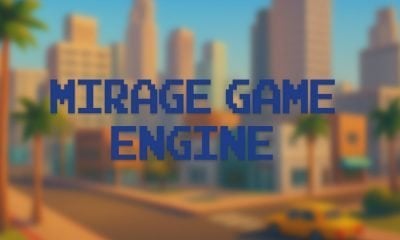Technology
Hunyuan World 1.0 Brings AI World-Building One Step Closer to Reality

AI in gaming is moving fast, and Tencent just dropped something that could change how we imagine game worlds. Hunyuan World Model 1.0 is an open-source AI that turns a single text prompt or image into a fully explorable 3D world. Imagine describing your dream game world in one sentence — “make me a cozy seaside town at sunset,” and within minutes, standing inside it and looking around the scene in 360°.
I’ve been digging through the report, community reactions, and real demos to understand if this is hype or a genuine leap for game development. Here’s everything you need to know.
What is Hunyuan World 1.0?
Hunyuan World Model 1.0 is an AI system that builds full 3D environments from a text prompt or a single image. Type “ancient desert ruins with glowing crystals”, and it gives you a 360° virtual world with terrain, sky, and objects you can explore.
Unlike most AI tools that output a flat image or single 3D object, Hunyuan3D produces layered 3D worlds. Each tree, rock, building, or prop comes out as a separate mesh, meaning you can move, edit, or delete them in a game engine. So, developers can export these worlds directly into Unity or Unreal, which makes it possible to prototype a playable environment in hours instead of weeks.
Even better, Tencent made the entire model open-source. Anyone can download it, run it locally, and even tweak it for their own projects. This is a rare move for a company of this scale and opens the door for indie developers to experiment freely.
How Hunyuan World 1.0 Is Able to Transform Words and Images into Virtual Worlds
Hunyuan 1.0 works a bit like popular AI image generators but with an extra leap into 3D. Regular AI tools like DALL·E or Stable Diffusion generate flat 2D images. Hunyuan starts in a similar way by imagining a 360° panoramic image based on your prompt or reference picture. But instead of stopping at a flat picture, it treats that panorama as the foundation for a full 3D environment.
Next, the AI breaks the scene into layers (for example – sky, ground, and foreground objects) so each part can be treated differently. This is where it differs from simple image-to-video tools, which only add movement to flat frames. Hunyuan adds depth and shape to each layer, turning objects like cars, rocks, or trees into actual 3D meshes instead of painted illusions. That’s why you can interact with these objects or export them into a game engine.
Behind the scenes, Hunyuan 1.0 works because it has been trained on massive datasets of 3D worlds, panoramic images, and object models. It learned how real environments are structured, like where the sky meets the horizon, how objects look from different angles, and how depth changes as you move. This training allows the AI to predict depth and shape from a single view, similar to how image-to-video AI predicts motion. In the end, the result is an interactive virtual world, not just a video or slideshow.
Is It Actually Useful Today?
Right now, Hunyuan World 1.0 is an early open-source AI model for 3D world generation. Here’s what it currently offers:
Quick Prototyping: Developers can generate a game level draft in minutes instead of modeling from scratch.
VR and simulations: It can create concept worlds for VR experiences or basic physical simulations.
Editable Assets: Objects are separate 3D meshes, which means they can be replaced, moved, or even made interactive in a game engine.
However, it’s still far from replacing traditional game development workflows. Some assets may have visual glitches or lack polish up close. It doesn’t handle gameplay design, logic, or story – humans still do the creative directing. It could be best seen as a powerful assistant that speeds up world-building rather than a hands-free game generator.
Where Could This Lead for Game Development?
If Hunyuan World 1.0 is the first step, the implications are huge. In the future, AI could handle tedious environment creation, letting game designers focus on storytelling and interactivity. Imagine small indie teams or even solo creators generating vast open worlds without needing an army of 3D artists.
But will it replace developers? Not yet. Game development isn’t just about visuals – it’s about experiences, mechanics, and emotional resonance. AI can give you a city, but it can’t design the mission that makes that city exciting to explore.
What we’re seeing is the rise of AI-assisted development. Studios could move faster, iterate more, and even let players generate custom worlds in the future. Tools like Hunyuan World 1.0 are the first glimpse of that era, where imagination moves closer to instant creation.
Final Thoughts
Hunyuan 1.0 isn’t a game developer in a box – it’s a creativity accelerator. It can generate immersive worlds, provide editable 3D assets, and give indie developers superpowers. While the tech is still evolving, it represents a big shift: AI is becoming a co-creator rather than just a helper.
We’ve already seen other AI projects try to generate virtual worlds, but most of them struggle with consistency. Scenes often look amazing from one angle, but start falling apart the moment you explore them. This is where Hunyuan 1.0 feels different. By generating true 3D assets, it has the potential to lock those worlds into place, solving one of the biggest headaches in AI-generated environments.
However, the road ahead still has challenges. Creating truly massive and reliable AI worlds will depend heavily on diverse, high-quality datasets. Without them, models may still miss fine details or produce repetitive environments.
If you’re a game dev, VR artist, or just a curious tech enthusiast, now is the time to experiment. The line between imagination and interactive worlds just got a little thinner, and Tencent’s Hunyuan World 1.0 is showing us what the next decade of game creation might look like.











